Stay powered for
your drive

You’ve got charging questions. We’ve got answers.
With electrified vehicles you no longer have to rely on gas as the only source of power. In fact, electric and fuel cell models don’t use fossil fuel at all. Which is why two of the most important questions many shoppers ask is, “How do I keep my electrified vehicle charged?” and “How does it fit into my life?” We’re here to answer these questions and more.
Charger Types
—
At home or on the go.
If you’re considering an EV or a plug-in hybrid, it’s important to understand the different types of chargers out there and how long each takes to power up your vehicle.

Level 1
This is the easiest home charging option, since you simply plug into a standard 120V AC outlet at your home. However, Level 1 charging takes significantly longer than other charging options.1
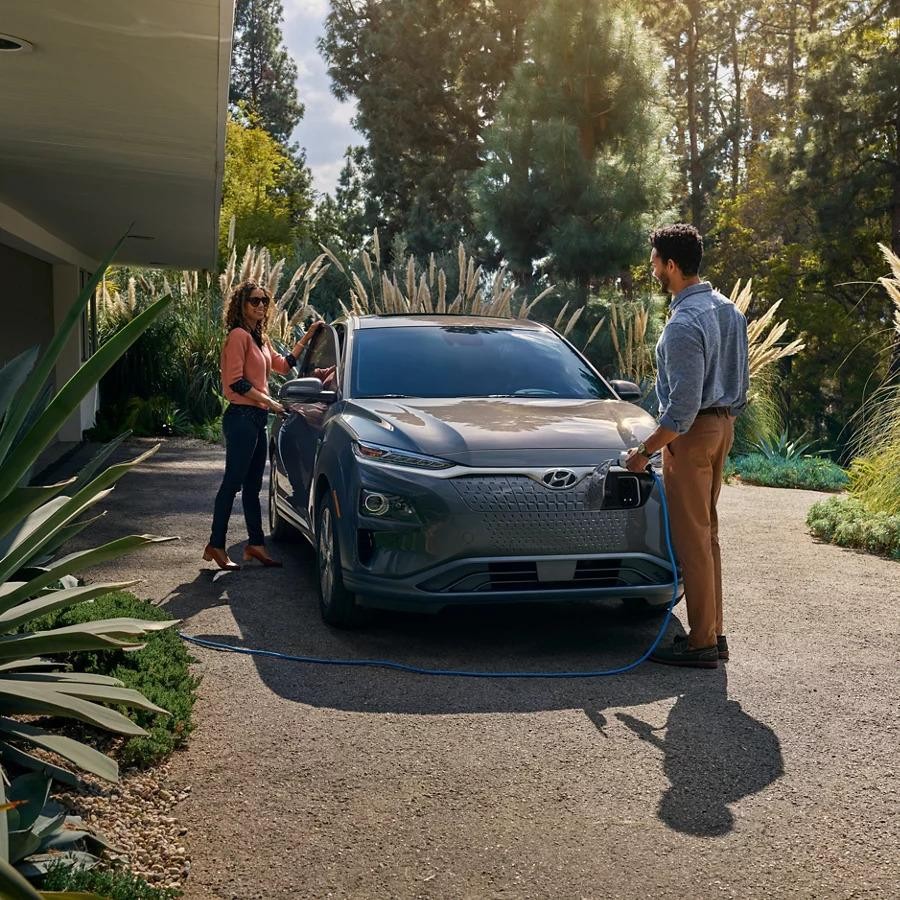
Level 2
The faster way to charge at home. Level 2 charging requires specialized equipment that plugs into a 240V AC outlet, which is typically used for larger appliances like dryers and water heaters. Fully charging your vehicle can take as little as 7 hours depending on the model and various conditions.1
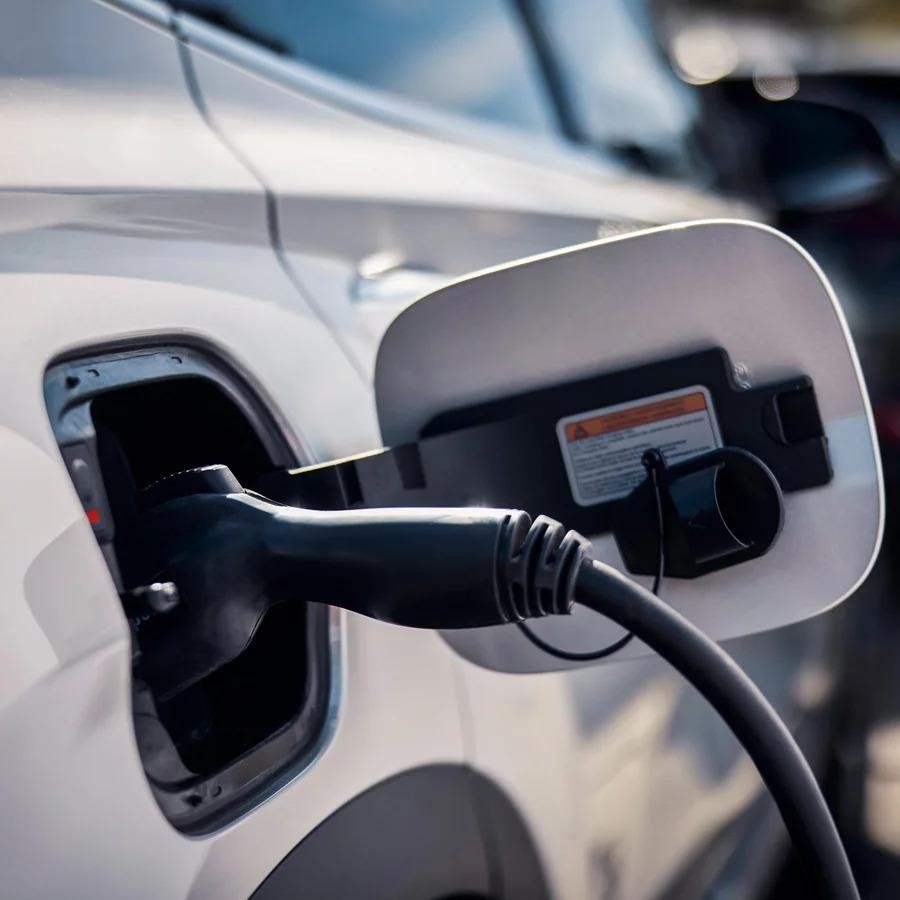
Level 3
Found at public locations like charging stations and shopping centers–check charging capabilities in your area using our map link below. Using over 480 volts, DC fast chargers can take your vehicle from 10% to 80% in as little as 25-64 minutes, depending on model. Even better, a 350-kW, 800V DC ultra-fast charger can power up an IONIQ 5 from 10 to 80% in just 18 minutes. And you get about 68 miles of range after 5 minutes of charging.2
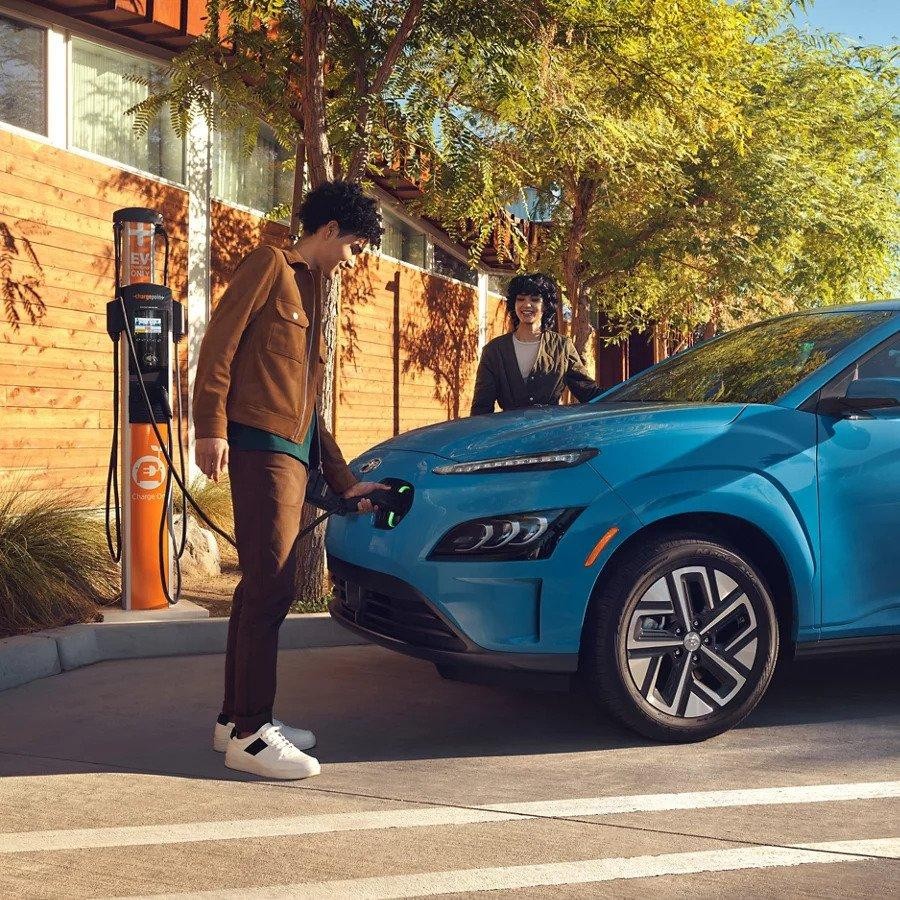
Charging stations map
–
It’s never been easier to find a charging station.
With an expansive network of DC fast-charging stations across the country, you can feel confident there’s always power ahead. And IONIQ 5 and KONA Electric qualify for limited complimentary charging with Electrify America.3
DC fast charging
—
Complimentary charging with Electrify America.
Electrify America has built an expansive network of DC fast-charging stations across the country, so you can feel confident there’s always power ahead. And when you purchase IONIQ 5 or KONA Electric, you get limited complimentary charging.3
Electrify America has built an expansive network of DC fast-charging stations across the country, so you can feel confident there’s always power ahead. And when you purchase IONIQ 5 or KONA Electric, you get limited complimentary charging.3
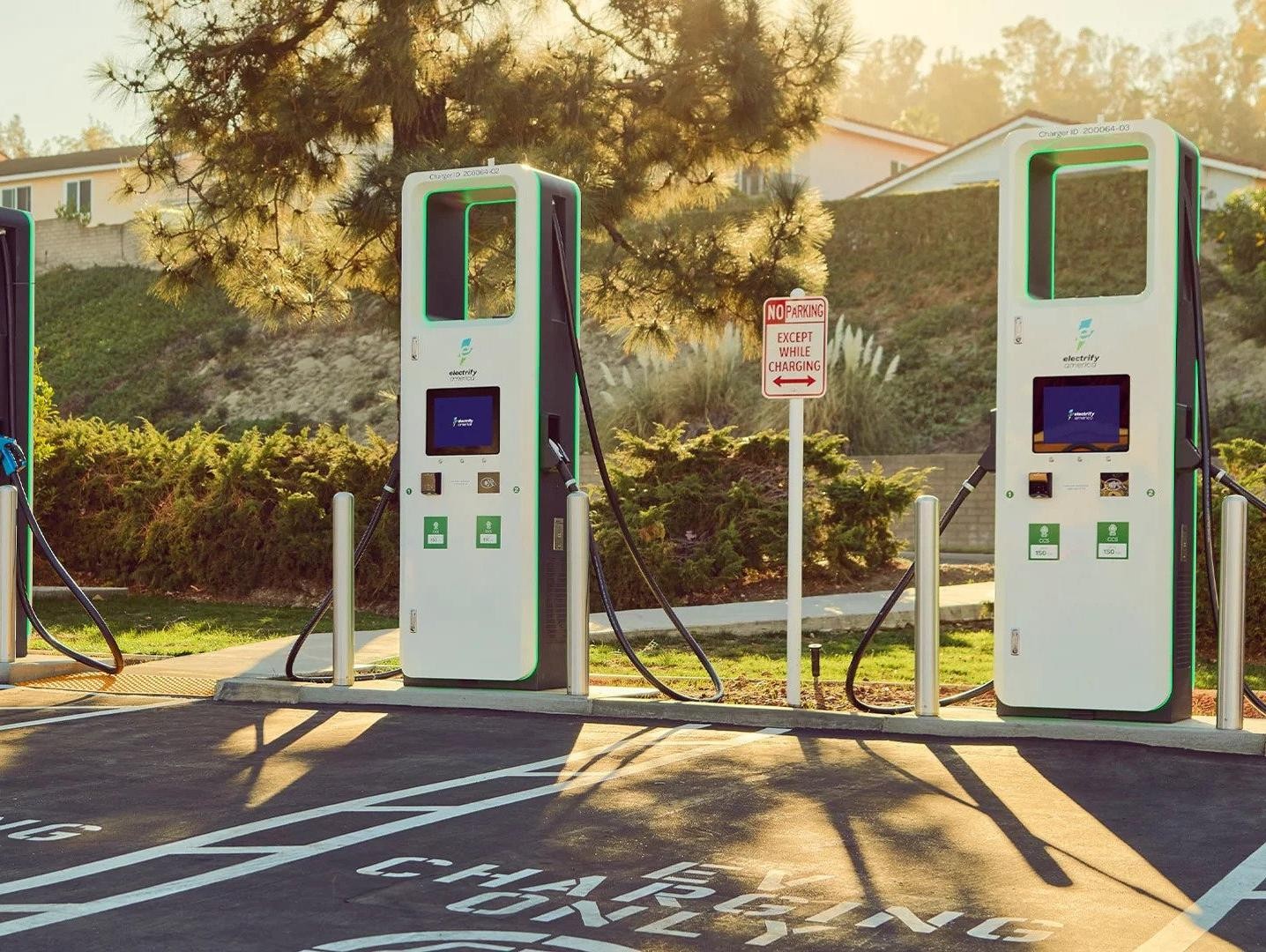

EV Route Planner
—
Know on the go where to recharge.
Hyundai navigation systems can locate charging stations along specific routes and refresh as you go. You can also view information about each station. The EV Route Planner also tells you how many charging stops you’ll need to make, as well as expected no-charging zones. So, you’re confident and prepared on every trip.
Hyundai navigation systems can locate charging stations along specific routes and refresh as you go. You can also view information about each station. The EV Route Planner also tells you how many charging stops you’ll need to make, as well as expected no-charging zones. So, you’re confident and prepared on every trip.
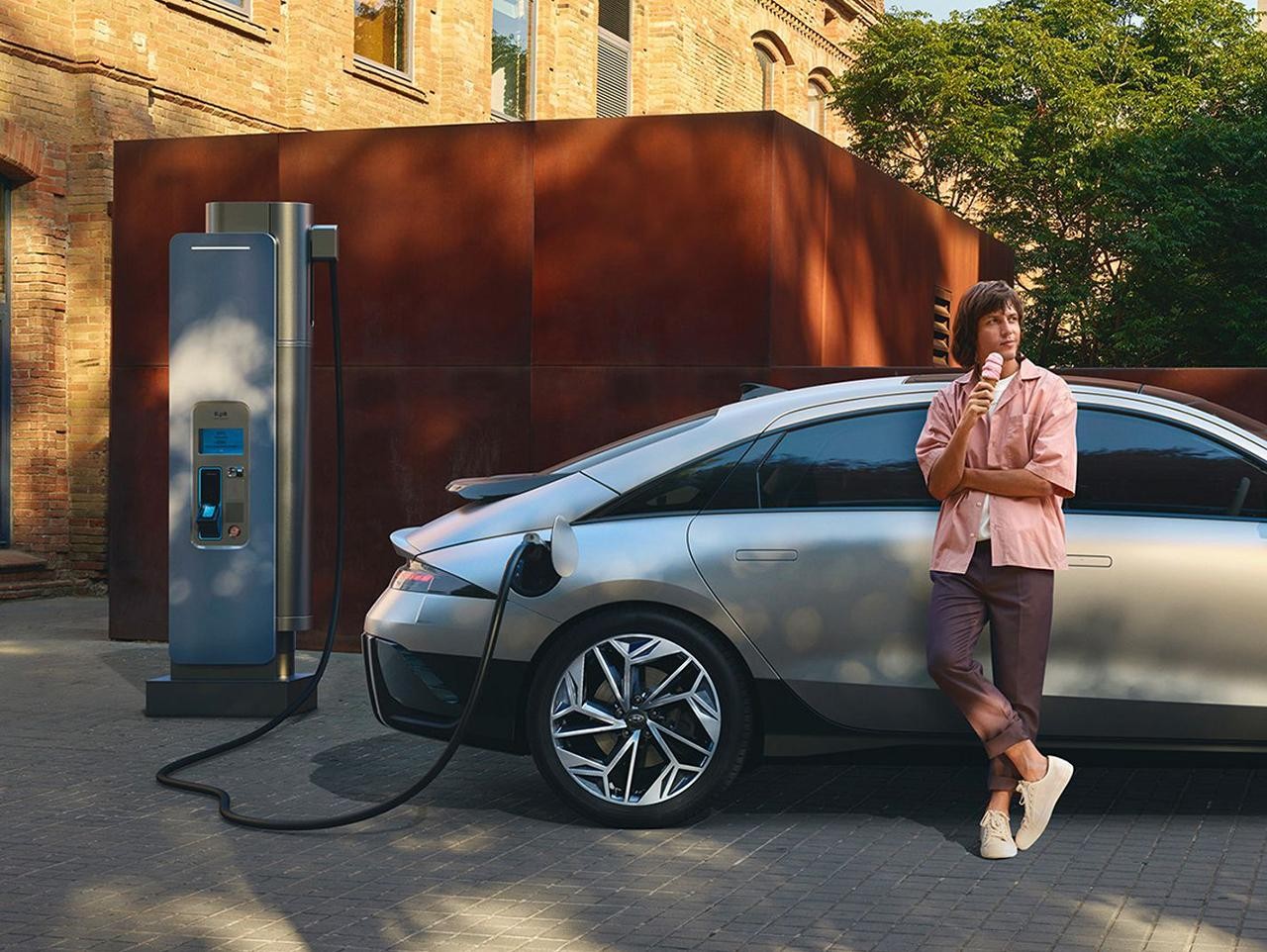
MPGe
—
What’s MPGe, exactly?
Making the switch from a gas to an electrified vehicle is a big decision. One great reason to go electric is lower overall energy costs. To make it easier to compare electric with gas models, the EPA created MPGe which stands for “miles per gallon of gasoline-equivalent.
Simply put, MPGe is the distance an EV can travel on 33.7 kWh of electricity, which is the energy equivalent of one gallon of gas. So, KONA Electric has a 120 Combined MPGe while our gas-powered KONA has 32 MPG Combined.* Based on a cost of $4.00 per gallon for a gas and $.25 per KwH of electricity, traveling 100 miles would cost $12.00 in gas for the KONA and just $7.00 for the KONA Electric.
You can also use MPGe to compare different types of electrified vehicles. For instance, NEXO Fuel Cell has 61 Combined MPGe while TUCSON Plug-in Hybrid has 80 Combined MPGe.4
You can also use MPGe to compare different types of electrified vehicles. For instance, NEXO Fuel Cell has 61 Combined MPGe while TUCSON Plug-in Hybrid has 80 Combined MPGe.4
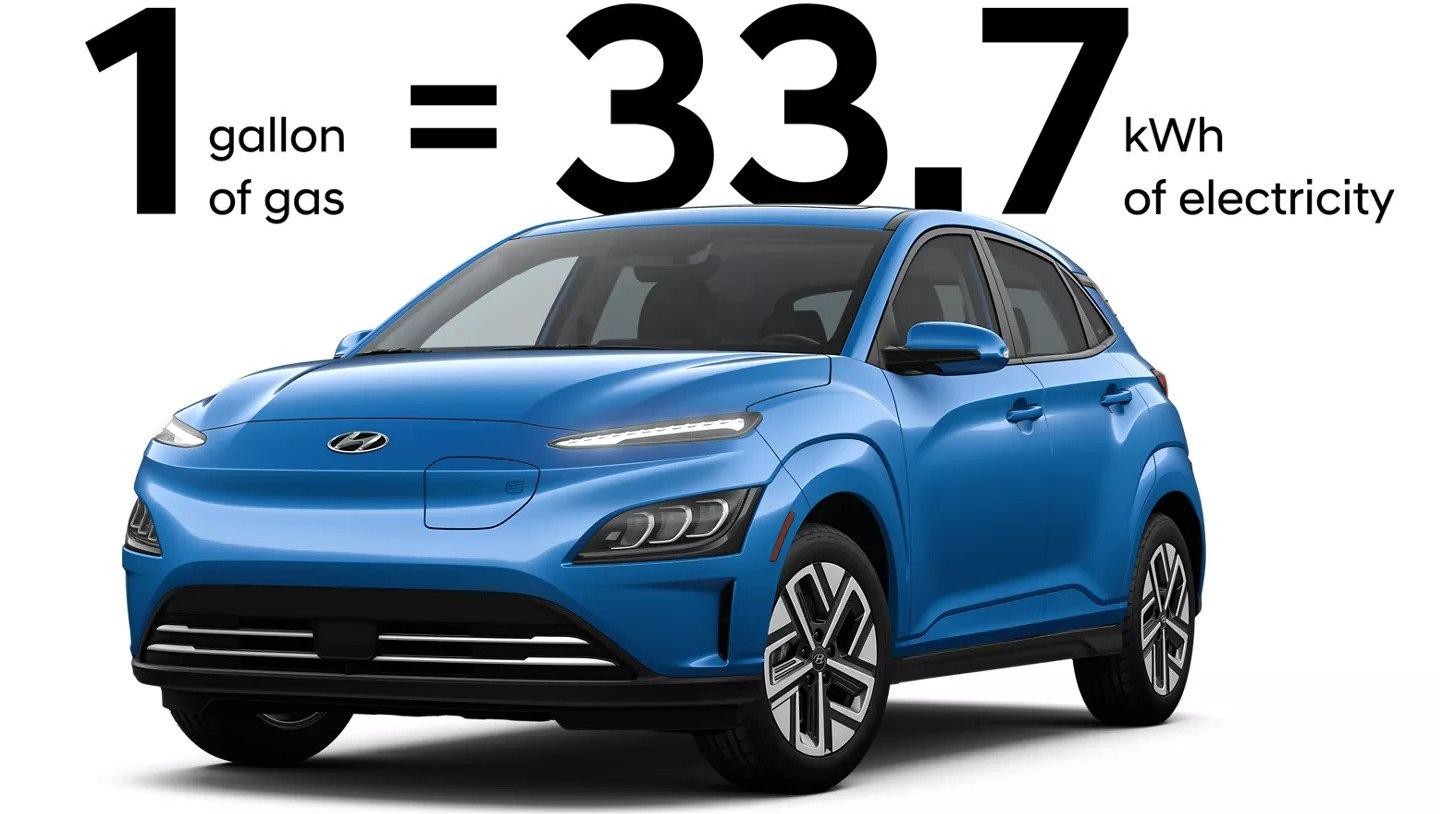
What affects range
—
—
Energy storage
The average EV battery stores less energy compared to gas tanks, so electric cars typically have lower total range compared to gas ones. While this means you’ll be recharging an electric vehicle more often, you’ll still be paying less overall due to electricity costing much less than gasoline.
The average EV battery stores less energy compared to gas tanks, so electric cars typically have lower total range compared to gas ones. While this means you’ll be recharging an electric vehicle more often, you’ll still be paying less overall due to electricity costing much less than gasoline.
Driving conditions
The range of electric and gas vehicles are both negatively impacted by cold weather, aggressive driving, cargo weight, and passengers. Air conditioning can also lower a hybrid’s driving range.
The range of electric and gas vehicles are both negatively impacted by cold weather, aggressive driving, cargo weight, and passengers. Air conditioning can also lower a hybrid’s driving range.
City or highway
Gas powertrains get their best MPG on the highway, but electric vehicles get better range in the city, thanks to regenerative braking.
Gas powertrains get their best MPG on the highway, but electric vehicles get better range in the city, thanks to regenerative braking.
Energy loss
Less than 40% of the energy produced by traditional gas engines actually power the vehicle—the rest is wasted as heat. Electric powertrains also lose some energy as heat via charging and the battery cooling system, but they’re still up to 90% efficient.
Less than 40% of the energy produced by traditional gas engines actually power the vehicle—the rest is wasted as heat. Electric powertrains also lose some energy as heat via charging and the battery cooling system, but they’re still up to 90% efficient.
Fuel cell charging
—
Electrified vehicles you fuel at the pump.
Since our NEXO Fuel Cell vehicle is powered by an electric motor that runs exclusively on hydrogen, refueling at a hydrogen station takes just 5 minutes and is similar to pumping gas.5
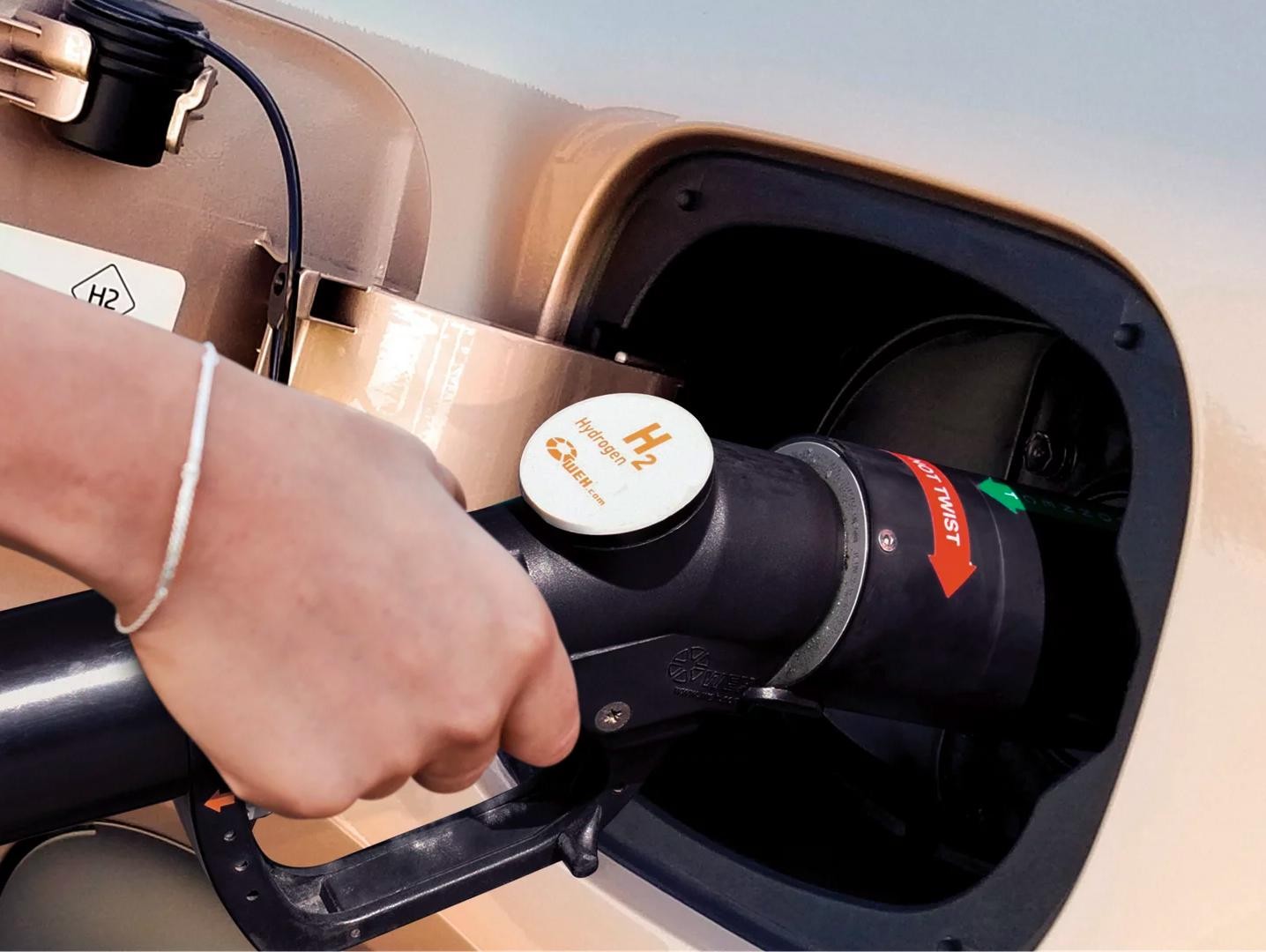
Regenerative breaking
—
Stopping power. Literally.
When it comes to charging, regenerative braking can help extend the range of all our electrified vehicles. When you coast or brake, the brakes turn the wheels’ rotations into electricity, which is stored in the battery. IONIQ 5, KONA Electric and NEXO Fuel Cell have control paddles behind the steering wheel, which let you choose from different levels of regenerative braking.
High
Set to higher levels of regenerative braking, you get more energy capture when decelerating. On IONIQ 5 you can use the i-Pedal function which activates the brakes when you take your foot off the accelerator, slowing to a complete stop.

Low
When you set to the lower levels of regenerative braking, you capture less energy but get longer, smoother coasting when you take your foot off the accelerator pedal.

Smart
Activate the Smart Regeneration System, and it automatically adjusts the regenerative braking level according to the speed and distance of the vehicle in front of you.

Home energy solutions
—
Introducing Hyundai Home.
Make your house as electrified as your electric vehicle. With Hyundai Home, you’ll have the power to take charge of your electricity with solar panels, energy storage systems and a 240-volt (Level 2) charger.6
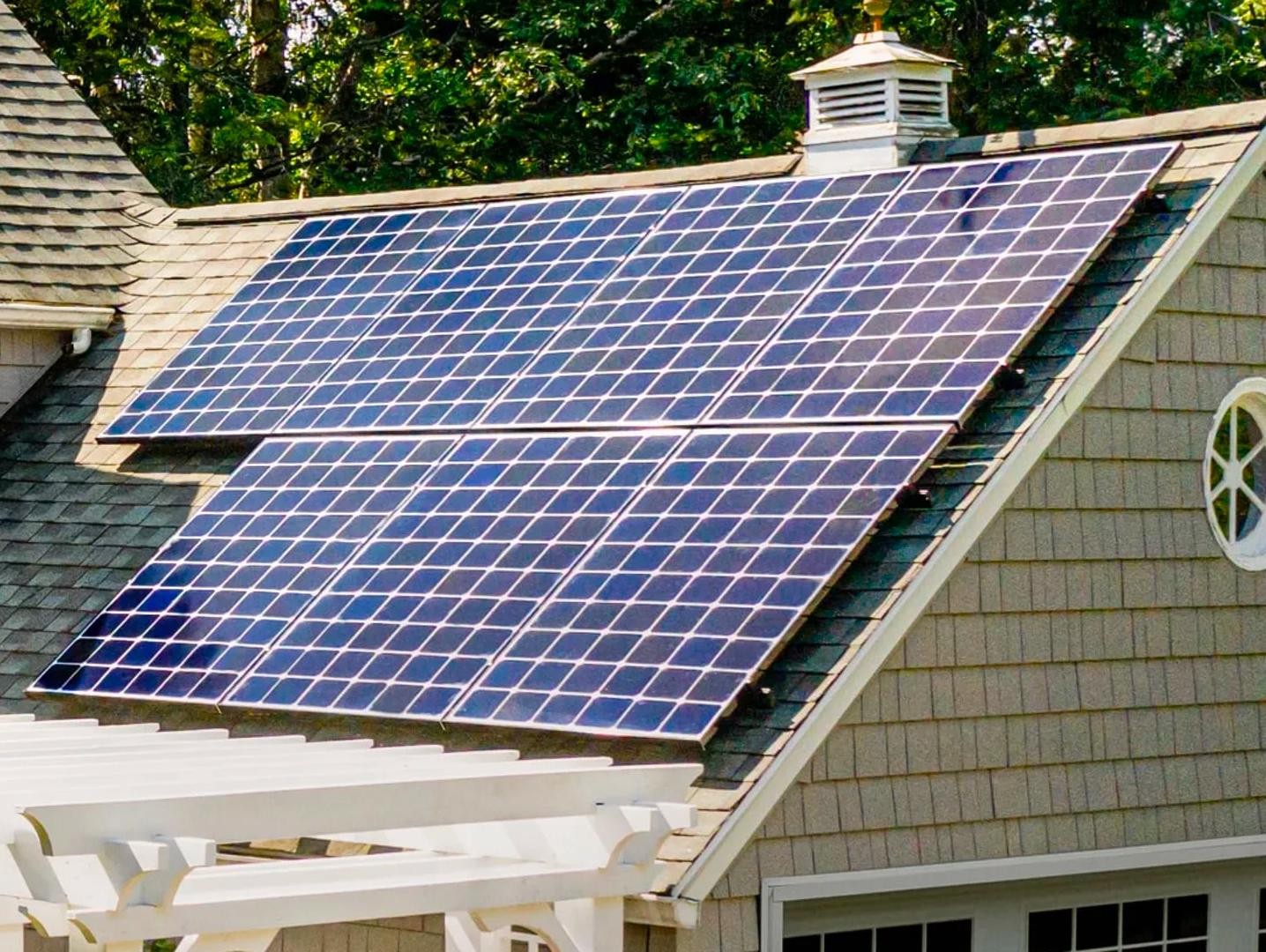
FAQ
—
Have questions about charging?
- Is charging equipment required for home charging my electric vehicle or plug-in hybrid?
- Can I initiate EV smart charging remotely?
- How long does it take to charge at public charging stations?
- Do electric cars charge while driving?
- How often should I charge my EV? Do I always need to charge it up to 100% or can I charge it halfway?
- What is the cheapest time of day to charge an electric vehicle?
- How far can I go on a single charge?
- Does outdoor temperature affect electric cars?
- How does my driving style affect the range of my vehicle?
Is charging equipment required for home charging my electric vehicle or plug-in hybrid?
You can plug into a standard 120V AC outlet at your home. Getting from 0% to a full charge can take up to 10 hours or more, depending on the vehicle and other conditions. Level 2 charging is much faster but requires specialized equipment that plugs into a 240V AC outlet, which is typically used for larger appliances like dryers and water heaters.
Can I initiate EV smart charging remotely?
How long does it take to charge at public charging stations?
Level 3 DC fast chargers can take your vehicle from 10% to 80% in as little as 25-64 minutes, depending on model. Level 4 350-kW, 800V DC ultra-fast chargers can power up an IONIQ 5 from 10 to 80% in just 18 minutes.8
Do electric cars charge while driving?
When you coast or brake, the regenerative brakes turn the wheels’ rotations into electricity, which is stored in the battery. IONIQ 5, KONA Electric, and NEXO Fuel Cell have control paddles behind the steering wheel, which let you choose from different levels of regenerative braking.
How often should I charge my EV? Do I always need to charge it up to 100% or can I charge it halfway?
You can charge as much as you need to get to where you are going. It doesn't need to be charged to 100% every time.
What is the cheapest time of day to charge an electric vehicle?
Electricity costs are typically lowest from 11 PM to 7 AM when energy demand is lowest. Check with your power company for off-peak times.
How far can I go on a single charge?
Among our electric models, currently the furthest you can go on a single charge is up to an EPA-est. 303 miles with IONIQ 5 and EPA-est. 258 miles with KONA Electric. With our plug-in hybrid models, you can go up to an EPA-est. 33 miles in all-electric mode with TUCSON Plug-in Hybrid and EPA-est. 30 miles with SANTA FE Plug-in Hybrid.9
Does outdoor temperature affect electric cars?
Cold temperatures can reduce an electric vehicle’s range by about 20 percent and recharging takes longer than in warm weather.
How does my driving style affect the range of my vehicle?
Faster acceleration and higher speeds use more power and therefore drain the battery quicker. Slower braking helps the regenerative brakes to capture more energy for the battery, which may help extend your vehicle’s range.
1. Actual charging time varies based on a number of factors, including the vehicle model and trim, current battery charge level, output of the charging unit, vehicle and battery settings, and outside temperature.
2. Actual charging time varies based on a number of factors, including the vehicle model and trim, current battery charge level, output of the charging unit, vehicle and battery settings, and outside temperature.
IONIQ 5 charging time approximately 18 minutes on a 350-kW, 800V DC EV Ultra-Fast Charger. Charging rate and time estimate varies based on a number of factors, including current battery charge level, output of the charging unit, vehicle and battery settings and outside temperature.
3. Available on new 2023 IONIQ 5 vehicles purchased from an authorized U.S.-based (excluding Alaska) Hyundai dealer on or before December 31, 2023. Two years of 30-minute complimentary DC fast charging sessions at Electrify America charging stations begins upon date of vehicle purchase. Non-transferable. Not available for commercial use, such as ride-hailing or ridesharing. Requires Electrify America account, app, acceptance of Terms of Use, and enrollment in Hyundai IONIQ 5 Charging Plan. After user-initiated charge session stops or vehicle reaches full charge or charging otherwise stops, and 10-min grace period, idle fees and applicable taxes will apply and user is responsible. There is a 60-minute waiting period between eligible charging sessions, and the plan benefits will not apply to a charging session initiated within this period. In the event of suspected fraud or abuse or other unforeseen events, Hyundai Motor America may discontinue or modify the offer in its sole discretion. Electrify America charging stations are only available in the continental U.S.
2021, 2022, and 2023 KONA Electric, purchased from an authorized U.S.-based (excluding Alaska) Hyundai dealer on or before December 31, 2023 qualify for limited complimentary charging. 250 kilowatt-hours of DC fast charging over three years begins upon vehicle purchase. Non-transferable. Not available for commercial use, such as ridesharing. Requires Electrify America account, app, acceptance of Terms of Use, and enrollment in Hyundai Premium Charging plan. After user-initiated charge session stop or vehicle reaches full charge or charging otherwise stops, and 10-min grace period, Idle Fees will apply and user is responsible. In the event of suspected fraud or abuse or other unforeseen events, Hyundai Motor America may discontinue or modify the offer in its sole discretion.
4. Total estimated monthly savings are based a price of $4.00 per gallon and cost of electricity per kilowatt hour at 25 cents; this pricing is for reference only. Actual values of savings will vary. Always check the local rates for electricity and the price of gasoline will vary to calculate your savings. For more information visit the US Department of Energy: https://afdc.energy.gov/fuels/electricity_benefits.html
2022 KONA Electric 258-mile range based on a fully charged battery and 120 combined MPGe. MPGe is the EPA-equivalent measure of gasoline fuel efficiency for electric mode operation.
2022 NEXO Fuel Cell Blue: 65 City/58 Hwy/61 Combined MPGe and 380-mile driving range. 2022 NEXO Fuel Cell Limited: 59 City/54 Hwy/57 Combined MPGe and 354-mile driving range.
2022 TUCSON Plug-in Hybrid. 33-mile All-Electric Range based on a fully charged battery pack and 80 MPGe. MPGe is the EPA-equivalent measure of gasoline fuel efficiency for electric-mode operation. 35 Combined MPG (gas).
2023 KONA SE & SEL Trim (2.0L I-4, IVT) – FWD: 30 City/35 Hwy/32 Combined; AWD: 28 City/33 Hwy/30 Combined. 2023 KONA N Line & Limited Trim (1.6T I-4, DCT) – FWD: 29 City/35 hwy/32 Combined; AWD: 27 City/32 Hwy/29 Combined.
All figures are EPA estimates and for comparison purposes only. Actual mileage may vary with options, driving conditions, driving habits and vehicle's condition.
5. Fueling time will vary based on ambient temperature, hydrogen fueling pressure, current fill level and other factors.
6. Solar panels, energy storage systems and the home EV charger are manufactured and offered by third parties. Currently, the home EV charger, solar panels and energy storage systems are available in select markets by referral from select Hyundai dealers. The Hyundai Home service will be available from additional dealers in 2023. Installation services are provided by third-party electricians sourced through the Hyundai Home service and contracted by customers for their projects.
7. Bluelink available on select Hyundai models and trims. Only use Bluelink and corresponding devices when safe to do so. Cellular and GPS coverage is required. Features, specifications, and fees are subject to change. For more on details and limitations, visit HyundaiUSA.com or your authorized Hyundai dealer.
8. Charging rate and time estimate varies based on a number of factors, including current battery charge level, output of the charging unit, vehicle and battery settings and outside temperature.
9. 2022 IONIQ 5 RWD 303-mile range based on a fully charged battery and combined MPGe. SE/SEL/Limited RWD: MPGe 132 City/98 Hwy/114 Combined MPGe and 303-mile driving range. SE/SEL/Limited AWD: MPGe 110 City/87 Hwy/90 Combined MPGe and 256-mile driving range. SE RWD (Standard Range): MPGe 127 City/94 Hwy/110 Combined MPGe and 220-mile driving range. MPGe is the EPA-equivalent measure of gasoline fuel efficiency for electric mode operation. All figures are EPA estimates and for comparison purposes only. Actual range and mileage will vary with options, driving conditions and habits, vehicle and battery's condition and other factors.
2023 KONA Electric 258-mile range based on a fully charged battery and 120 Combined MPGe. MPGe is the EPA-equivalent measure of gasoline fuel efficiency for electric mode operation. All figures are EPA estimates and for comparison purposes only. Actual range and mileage will vary with options, driving conditions and habits, vehicle and battery's condition and other factors.
2022 TUCSON Plug-in Hybrid. 33-mile All-Electric Range based on a fully charged battery pack and 80 MPGe. MPGe is the EPA-equivalent measure of gasoline fuel efficiency for electric-mode operation. 35 Combined MPG (gas). All figures are EPA estimates and for comparison purposes only. Actual range and mileage will vary with options, driving conditions and habits, vehicle and battery's condition and other factors.
2022 SANTA FE Plug-in Hybrid 30-mile All-Electric Range based on a fully charged battery pack and 76 HTRAC AWD Combined MPGe. MPGe is the EPA-equivalent measure of gasoline fuel efficiency for electric-mode operation. 33 Combined MPG (gas). All figures are EPA estimates and for comparison purposes only. Actual range and mileage will vary with options, driving conditions and habits, vehicle and battery's condition and other factors.



